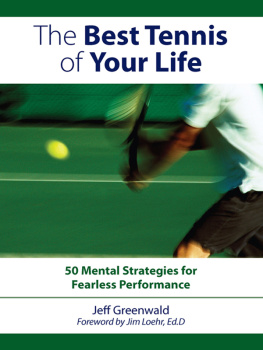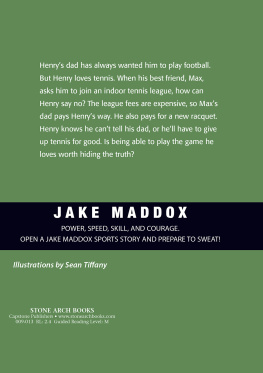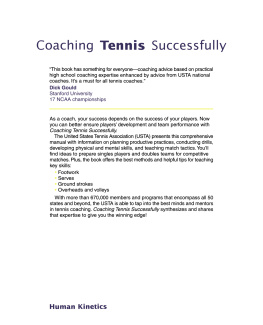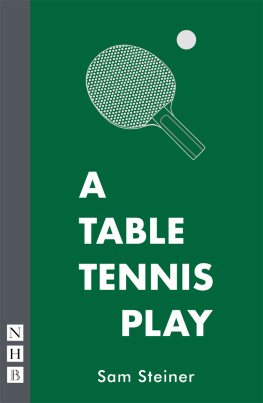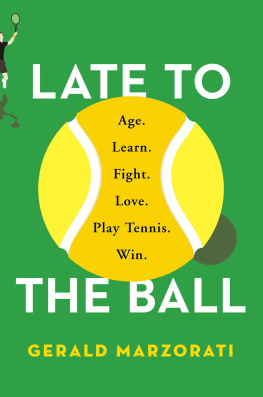play better tennis in 2 hours
Simplify the game and PLAY like THE PROS
OSCAR WEGNER
WITH Steven Ferry



Copyright 2005 by Oscar Wegner. All rights reserved. Except as permitted under the United States Copyright Act of 1976, no part of this publication may be reproduced or distributed in any form or by any means, or stored in a database or retrieval system, without the prior written permission of the publisher.
ISBN: 978-0-07-178267-8
MHID: 0-07-178267-2
The material in this eBook also appears in the print version of this title: ISBN: 978-0-07-143717-2, MHID: 0-07-143717-7.
All trademarks are trademarks of their respective owners. Rather than put a trademark symbol after every occurrence of a trademarked name, we use names in an editorial fashion only, and to the benefit of the trademark owner, with no intention of infringement of the trademark. Where such designations appear in this book, they have been printed with initial caps.
McGraw-Hill eBooks are available at special quantity discounts to use as premiums and sales promotions, or for use in corporate training programs. To contact a representative please e-mail us at bulksales@mcgraw-hill.com.
Photograph on page iii by Lucidio Studio Inc./Corbis.
Photographs by Steven Ferry unless otherwise noted.
Illustrations by Deirdre Newman.
TERMS OF USE
This is a copyrighted work and The McGraw-Hill Companies, Inc. (McGraw-Hill) and its licensors reserve all rights in and to the work. Use of this work is subject to these terms. Except as permitted under the Copyright Act of 1976 and the right to store and retrieve one copy of the work, you may not decompile, disassemble, reverse engineer, reproduce, modify, create derivative works based upon, transmit, distribute, disseminate, sell, publish or sublicense the work or any part of it without McGraw-Hills prior consent. You may use the work for your own noncommercial and personal use; any other use of the work is strictly prohibited. Your right to use the work may be terminated if you fail to comply with these terms.
THE WORK IS PROVIDED AS IS. McGRAW-HILL AND ITS LICENSORS MAKE NO GUARANTEES OR WARRANTIES AS TO THE ACCURACY, ADEQUACY OR COMPLETENESS OF OR RESULTS TO BE OBTAINED FROM USING THE WORK, INCLUDING ANY INFORMATION THAT CAN BE ACCESSED THROUGH THE WORK VIA HYPERLINK OR OTHERWISE, AND EXPRESSLY DISCLAIM ANY WARRANTY, EXPRESS OR IMPLIED, INCLUDING BUT NOT LIMITED TO IMPLIED WARRANTIES OF MERCHANTABILITY OR FITNESS FOR A PARTICULAR PURPOSE. McGraw-Hill and its licensors do not warrant or guarantee that the functions contained in the work will meet your requirements or that its operation will be uninterrupted or error free. Neither McGraw-Hill nor its licensors shall be liable to you or anyone else for any inaccuracy, error or omission, regardless of cause, in the work or for any damages resulting therefrom. McGraw-Hill has no responsibility for the content of any information accessed through the work. Under no circumstances shall McGraw-Hill and/or its licensors be liable for any indirect, incidental, special, punitive, consequential or similar damages that result from the use of or inability to use the work, even if any of them has been advised of the possibility of such damages. This limitation of liability shall apply to any claim or cause whatsoever whether such claim or cause arises in contract, tort or otherwise.
contents
acknowledgments
I WOULD LIKE to thank these former top players for personally showing me the best of their game: Pancho Gonzalez, the serve; Pancho Segura, the two-handed forehand; Roy Emerson, the volleys; and Manuel Santana, the topspin forehand.
I would also like to thank Nina Bers, 1987 U.S. Junior Intercollegiate tennis champion, for her patient modeling for the photographs; Steven Ferry, for helping me write and photograph this book; and most of all, L. Ron Hubbard, who inspired my life with his works and insights into teaching and the nature of the human spirit.
introduction
IN THE 1960s, less than 10 million people played tennis in the United States. Then in 1968, professionals and amateurs were allowed to compete together for the first time in open tournaments, sparking an explosion of interest and TV exposure for the game. As a result, by the late 1970s, close to 40 million Americans were playing tennis.
However by the beginning of 2000, industry figures showed the number of players only ranged between 16 and 23 million, while official figures from the United States Tennis Association showed three times this number had left the game over the last twenty years.
Why did this happen?
As unpalatable as it may seem, the answer is from incorrect instructiontennis had been taught one way, while the top pros played a completely different way.
That is until I ended my international playing days and began coaching at the Beverly Hills Tennis Club in California as an assistant to Pancho Segura, considered one of the greatest coaches ever. I soon realized that the most important details of the top pros games were not only neglected but also actually violated by both conventional coaching and most entry-level teaching.
My own forehand stroke had been affected by poor coaching. Formerly a powerful, stinging weapon I had found on my own as a child, it was rendered inaccurate and ineffective during my tour-playing days after I was counseled to play the proper way. Something was amiss.
Once I was free of the competitive pressures of the tennis tour, I discovered the answer to the riddletennis had been made too complicated. Simple. I then isolated the common denominators of the best strokes, and by establishing what was important to learn and what was not, I found that tennis was a game of hand-eye coordination onlynot hand-eye-feet, as had been widely taught.
When focusing a player on hand movement only, I noticed the body coordinated itself naturally, resulting in the same fluid motions as the pros.
Just by following very simple but specific instructions on how to stroke the ball, and still focusing on the hand, players experienced an incredibly rapid rate of improvement. In the same way, you should expect to be a changed player after a couple of hours practicing this fundamental truth.
Beginners, when not overriding the motions they had acquired in learning to walk and run, found tennis to be an easy sport to learn. Beyond this, you, like all players, just need to determine the best way to handle the ball, maximizing your feel, power, and controlall of which the drills in this book make possible. This book will integrate the best techniques available with your own unique physique and develop your tennis based on your natural motor skills.
The Results
Encouraged by Pancho Segura, I first tested these fundamentals on a large following of Hollywood clientele, including Charlton Heston, Dinah Shore, and Dean Martin Jr. (whose tennis looked so good after his training that he was cast playing in the Wimbledon singles final against Guillermo Vilas in the movie Players).
The Spanish Tennis Federation hired me in 1973 to coach the top juniors at the National Tennis School. I applied these same fundamentals, despite opposition from leading Spanish coaches, with astounding results. Within three months of my arrival, Spanish players using my techniques eliminated all the international competitors in the Monte Carlo Junior Tournament, resulting in four Spanish semifinalists. The coaches accepted the evidence and adopted my methods. From then on, Spain didnt have just a few winnersit had a crowd of them, an influx of new talent that continues to this day!




